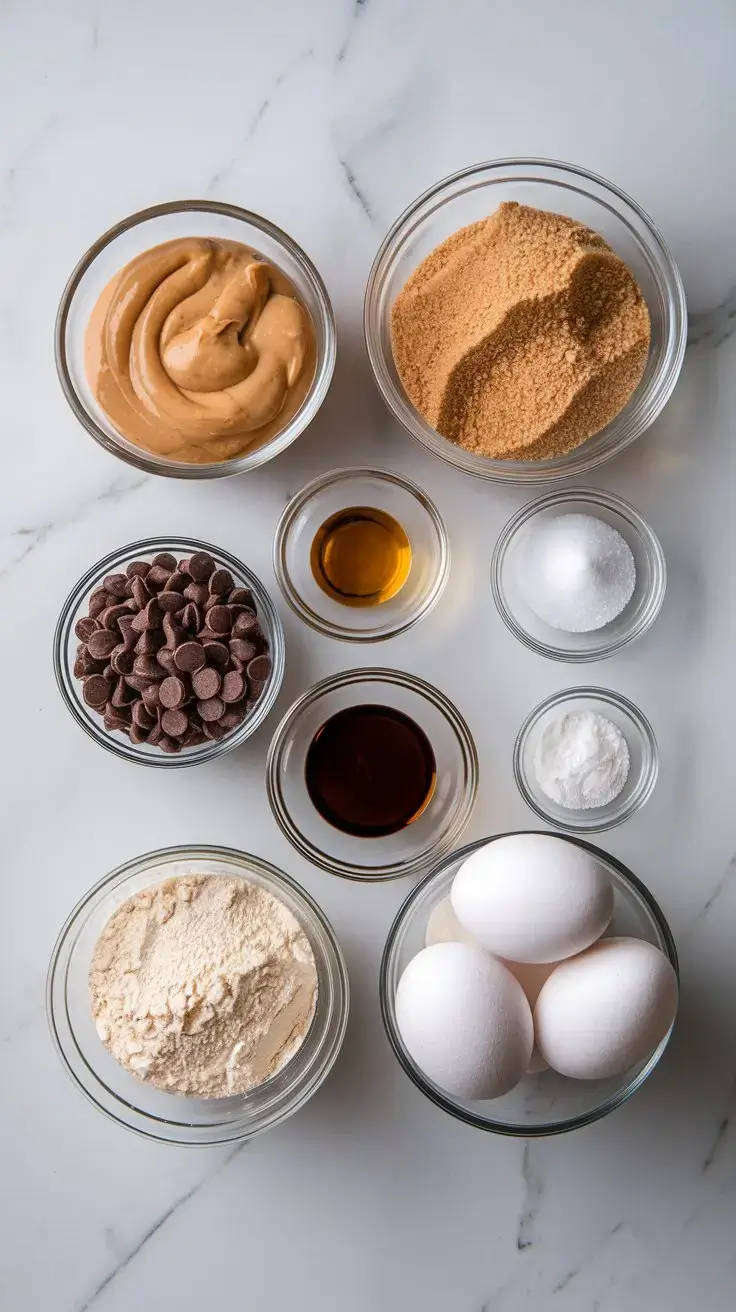Protein cookies are a blend of traditional cookie appeal and enhanced nutritional value, designed for health-conscious individuals and fitness enthusiasts.
Unlike regular cookies, these snacks are fortified with high-quality protein sources, making them a functional food that supports a healthier lifestyle. The rising popularity of protein cookies is due to the increased awareness of nutritional needs and a shift towards healthier eating habits.
These cookies offer a convenient, delicious, and nutritious option that aligns with today’s busy lifestyles.

Key Benefits of Protein Cookies
Protein cookies provide a significant amount of protein essential for muscle repair, growth, and bodily functions. They contain less sugar and fats than regular cookies and may include fiber, healthy fats, and essential vitamins and minerals. This makes them a satisfying, filling snack that helps with weight management and provides sustained energy without the sugar crash.
Nutritional Benefits of Protein Cookies
Role of Protein
Protein is really important for muscle repair and growth, making it important for athletes and those leading active lifestyles. It also supports enzyme function, immune system responses, metabolic processes, and provides structural support to cells and tissues.
Protein Sources
1. Whey Protein: Derived from milk, it is quickly absorbed, ideal for post-workout recovery.
2. Casein Protein: Also from milk, digests slowly, perfect for consuming before periods of fasting.
3. Plant-Based Proteins: Include sources like peas, rice, and soy, essential for vegans and vegetarians.
Balanced Macronutrients
Protein cookies are designed to offer a balanced profile of macronutrients:
- Proteins: As the key ingredient, proteins in these cookies help in satiety and muscle maintenance.
- Carbohydrates: Often sourced from whole grains, they provide energy and help in the recovery of muscle glycogen stores post-exercise.
- Fats: Healthy fats from nuts, seeds, or oils are included to support hormone production and provide essential fatty acids.
Fiber Content
The fiber in protein cookies promotes digestive health, aids in weight management, and helps maintain steady energy levels. They are a smart choice for health-conscious individuals.
Protein Source Comparison
The type of protein used can affect both the nutritional value and digestibility of the cookie:
- Whey Protein: Quick to digest and rich in branched-chain amino acids (BCAAs), whey is ideal for post-workout recovery as it helps to quickly repair and build muscle tissue.
- Casein Protein: This protein digests slowly, making it excellent for providing a steady supply of amino acids over several hours, which can help in reducing muscle breakdown and supporting overnight recovery.
- Plant-Based Proteins: Typically featuring a blend of sources like pea, rice, or hemp, plant-based proteins are fantastic for those following a vegan diet. While some plant proteins may lack one or more essential amino acids, blends are often designed to provide a complete amino acid profile.
Taste Preferences
When choosing a protein cookie, consider both nutrition and flavor. Try different flavors to find one that meets your nutritional needs and tastes great. Look for a balance between ingredients, nutritional benefits, and personal taste preferences to support your health goals while enjoying your snack.
Types of Protein Cookies
Varieties Available
The protein cookie market offers options to cater to different dietary needs, including gluten-free, vegan, low-carb, and paleo-friendly varieties. These cookies come in soft-baked and crunchy textures to suit different preferences.
Protein Source and Flavors
The protein sources in these cookies vary widely, each bringing its unique nutritional profile:
- Whey Protein Cookies: Popular among athletes, these cookies are excellent for muscle recovery due to whey’s rapid absorption rate.
- Casein Protein Cookies: Best consumed as a bedtime snack, casein provides a slow release of amino acids, aiding in muscle recovery overnight.
- Plant-Based Protein Cookies: Using proteins from peas, rice, or even nuts, these cookies are ideal for vegans and those with dairy allergies. They’re designed to deliver a complete protein profile through the combination of various plant sources.
As for flavors, protein cookies have evolved far beyond the basic vanilla and chocolate. Some of the most popular flavors include:
- Chocolate Chip: A classic favorite that combines the comforting taste of chocolate with the nutritious benefits of protein.
- Peanut Butter: Offers a rich, satisfying taste along with an additional protein boost from the peanuts themselves.
- Oatmeal Raisin: Provides a chewy texture with bursts of sweetness from the raisins, making it a perfect snack for sustained energy.
- Snickerdoodle: Cinnamon-spiced and sweet, this flavor is a delightful treat that doesn’t feel like a typical health food.
Homemade Protein Cookies

Advantages of Home Baking
Creating protein cookies at home gives you control over ingredients, allowing you to avoid preservatives and adjust the recipe to meet dietary needs. It’s also cost-effective if you regularly consume protein cookies.
Recipe Adaptations
Converting a regular cookie recipe into a high-protein version isn’t as daunting as it might sound. The key is to balance the texture and flavor while boosting the nutritional content:
- Protein Powder: Substitute a portion of the flour with protein powder. For example, if a recipe calls for 1 cup of flour, use ¾ cup of flour and ¼ cup of protein powder.
- Add Nuts and Seeds: Incorporate finely ground nuts or seeds such as almonds, flax, or chia to increase protein content naturally.
- Use Nut Butter: Replace some of the butter or oil with peanut or almond butter to enhance the protein while maintaining moisture.
Ingredient Substitutions
Here are some recommended swaps to increase protein content in your cookies:
- Flour: Replace all-purpose flour with almond flour, coconut flour, or oat flour for additional protein and fiber.
- Sweeteners: Opt for natural sweeteners like pureed dates or honey instead of white sugar; they provide nutrients along with sweetness.
- Eggs: If your recipe calls for more structure, adding an extra egg or two can boost protein content and help bind the cookies.

How to Make Protein Cookies
Here’s an easy-to-follow recipe for beginners wanting to make homemade protein cookies:
PrintProtein Cookies—An Easy, Healthy Treat
OMG! You have to try these amazing Chocolate Chip Protein Cookies! 🍪 I’ve just whipped up the most delicious, chewy cookies that pack a punch of protein—14g per cookie! These treats are loaded with peanut butter and chocolate chips, and ready in only 20 minutes! Perfect for a healthy dessert or snack that’s both tasty and guilt-free! Who’s ready to dive into this protein-packed indulgence?
- Total Time: 19 minutes
- Yield: 9 servings 1x
Ingredients
Ingredients:
- 2 eggs
- ⅔ cup unsalted peanut butter
- ½ cup granulated sugar (white, coconut, or brown sugar)
- 1 teaspoon vanilla extract
- ½ cup vanilla protein powder
- ½ teaspoon baking soda
- ¼ teaspoon salt (omit if using salted peanut butter)
- ½ cup chocolate chips
Instructions
Instructions:
- Preheat your oven to 350°F (175°C) and line a baking sheet with parchment paper.
- In a mixing bowl, whisk together the eggs, peanut butter, sugar, and vanilla until smooth.
- Fold in the protein powder, baking soda, and salt. The dough will be thick.
- Stir in the chocolate chips.
- Using a 2-tablespoon scoop, form dough balls and flatten them slightly. They won’t spread much during baking.
- Bake for 8-12 minutes (10 minutes works well for most ovens). They will firm up as they cool.
- Let the cookies cool on the baking sheet for 20 minutes before serving.
Notes
- Store the cookies in an airtight container for up to 3 days.
- To freeze, let them cool completely, then freeze for up to 1 month. Reheat directly from the freezer at 300°F until warmed through.
- For a vegan option, try a different recipe as the eggs are essential in this one.
- Prep Time: 10 minutes
- Cook Time: 9 minutes
- Category: Dessert
- Method: Baking
- Cuisine: American
Nutrition
- Calories: 246 kcal
- Sugar: 15g
- Fat: 14g
- Carbohydrates: 24g
- Protein: 14g
Keywords: #ProteinCookies #HealthyDessert #GuiltFreeTreat #SnackGoals #PeanutButterLove #FitnessFuel #EasyRecipes
Challenges in Baking High-Protein Cookies
Common Issues
When baking high-protein cookies, challenges may arise from protein powders absorbing more liquid than flour, resulting in drier, denser cookies. Additionally, the lack of gluten in high-protein flours can lead to a less cohesive dough and a crumbly texture.
Quality and Appearance
The addition of protein powders can significantly alter the texture and taste .
- Texture: Become tougher and chewier than their traditional counterparts, especially if overmixed.
- Flavor: Have a distinct taste depending on the type of protein used; for example, whey protein can impart a slight milkiness, while plant-based proteins might introduce earthy notes.
- Appearance: Exhibit less spread during baking, resulting in thicker, more compact cookies.
Solutions
To improve high-protein cookies:
1. Increase moisture with eggs, milk, or oil.
2. Mix dough lightly to avoid toughness.
3. Adjust leavening agents for proper rise.
4. Let dough rest before baking.
5. Experiment with small batches.
6. Add flavor enhancers like vanilla or cinnamon to improve taste.
Protein Cookies and Weight Management
Satiety and Appetite
Protein promotes fullness, reducing overall calorie intake – making high-protein snacks like protein cookies great for managing weight. It slows digestion, leading to prolonged fullness and delayed hunger, helping with weight loss and maintenance.
Fitness Goals
Pre-Workout: Consuming a protein cookie before exercising can provide a fast and convenient source of energy without feeling too heavy or full, ideal for fueling short to medium-intensity workouts.
Post-Workout Recovery: Protein is crucial for muscle repair and growth. Eating a protein cookie after a workout can help replenish protein stores and aid in the recovery of muscle tissues, promoting muscle growth and reducing soreness.
Portion Control
While protein cookies are a healthier alternative to traditional cookies, managing consumption is key to reaping their health benefits without overindulging. Here are some tips for effective portion control:
- Size Matters: Opt for smaller cookies or those that come in controlled portions to avoid overeating.
- Scheduled Snacking: Incorporate protein cookies into your meal plan as a scheduled snack rather than an impromptu treat. This helps manage hunger between meals without compromising calorie control.
- Balanced Diet: Ensure that protein cookies complement a balanced diet. They should not replace whole foods such as fruits, , lean proteins, vegetables, and whole grains but rather serve as a supplement to your overall nutritional intake.
Summary of Benefits
Protein cookies offer high-quality protein for muscle repair and growth and help manage appetite. They provide a healthier option to traditional cookies with beneficial fats, fibers, and lower sugar content. They also cater to various dietary needs, including vegan, gluten-free, and allergy-friendly options.
Dietary Integration
These treats can add nutritional value as on-the-go snacks, post-workout recovery aids, or meal replacements. However, they should complement a diet rich in fruits and vegetables, whole grains, and also lean proteins, contributing to a well-rounded diet without displacing essential nutrients.
As consumers become more health-conscious, the demand for cookies made from organic and non-GMO ingredients is expected to rise. The future of these goodies looks promising as they evolve to meet the health, ethical, and dietary preferences of a broader audience.
More Healthy Goodies Ideas:
High Protein Meal Prep: Complement your protein cookies with high-protein meals for sustained energy throughout the week
Quinoa Kale Salad: This fresh quinoa and kale salad is a perfect nutrient-packed side to balance out your protein cookies.
Blueberry Oatmeal Muffins: Pair these fiber-rich blueberry oatmeal muffins with protein cookies for a wholesome snack.
Eggless Banana Bread: This moist eggless banana bread is a great plant-based companion to your protein cookies.
Gluten-Free Sourdough Bread: Add this gluten-free sourdough bread to your meal for a hearty, tangy pairing .
Problems and Solutions for High-Protein Cookies: Encounter common issues when baking with high protein mixtures? This resource addresses potential problems and offers practical solutions to help you perfect your protein cookie baking technique. Learn more here.


